This delicious and authentic vegan and gluten-free recipe of Korean fried rice or Bokkeumbap is packed with kimchi, gochujang, and veggies. A quick and easy meal that uses up leftovers and can be made in just 15 minutes! Add this easy Korean Kimchi Bokkeumbap recipe to your weekly menu rotation.
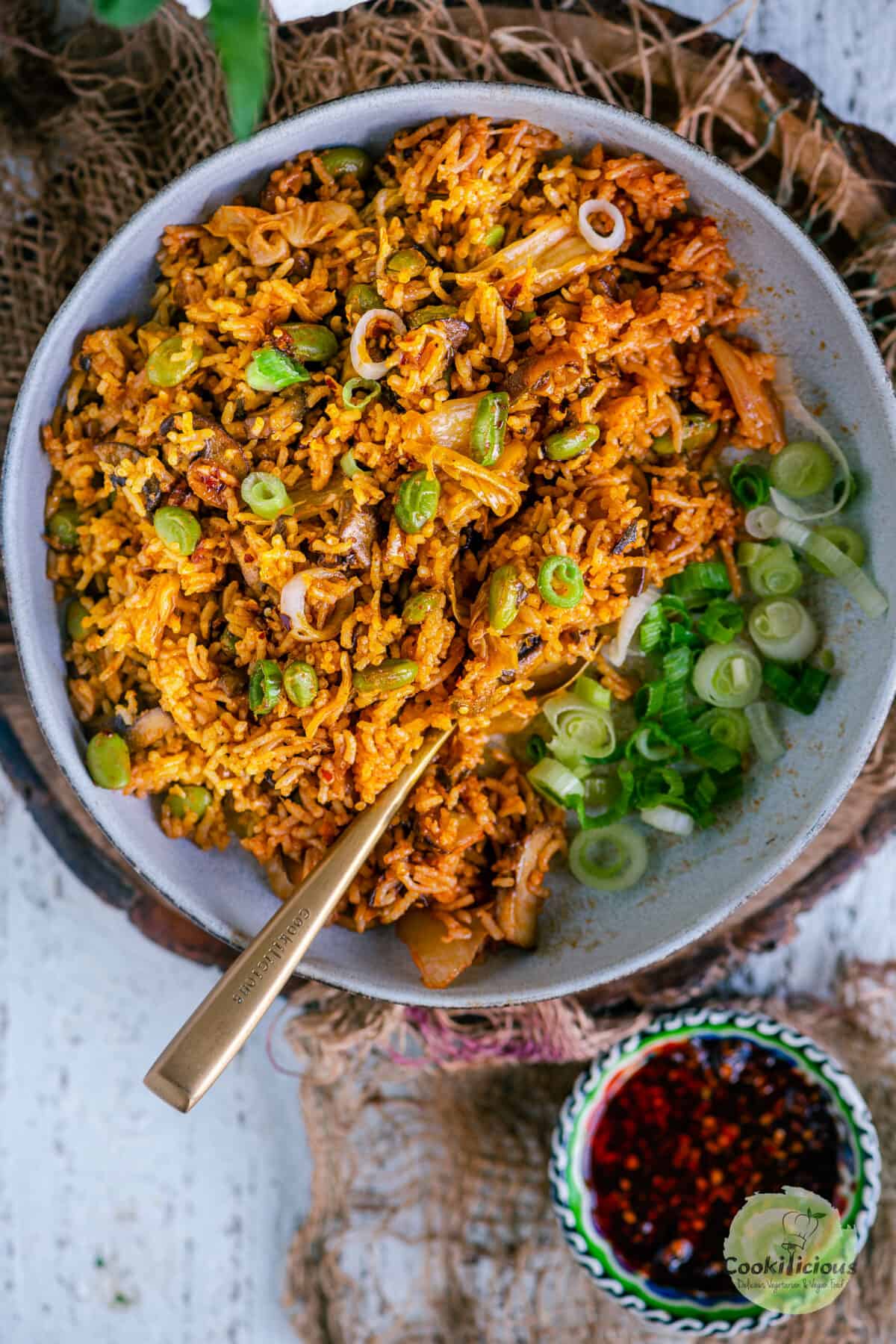
Jump to:
What is Korean fried rice
Also known as Kimchi Bokkeumbap (which means fried rice), Kimchi, or Gochujang Fried Rice, it is a popular dish in South Korea. Korean Bokkeumbap recipe is packed with robust flavors because it's made with these two main ingredients - Gochujang and Kimchi. In this easy recipe, over-ripened kimchi along with vegetables and sauces is cooked with mostly leftover rice and is often served for breakfast.
Also referred to as a hangover meal, this thrifty Korean comfort food is like the Indian Dal, every Korean household has its own way of making it. It's also a popular street food that's even served in Korean restaurants. BTW, it isn't as spicy as it looks! You can control the spice levels. I am finally able to get more vegetarian and vegan Asian food influence into my family's menu with this recipe and Scallion Pancakes.
What is Kimchi
Kimchi (Kimchee) means soaked vegetables in Korean. It is a spicy Korean banchan made with fermented vegetables like napa cabbage or Korean radish that tastes similar to sauerkraut. Texture-wise, the kimchi has a slightly crunchy texture. Over-fermented Korean kimchi is full of nutrients and healthy microbes. It also aids in digestion. Some other veggies used to make kimchi are cucumbers, lotus root, eggplant, and green onions.
Choosing the right kimchi
You can make many Korean dishes with kimchi and this Bokkeumbap is one of them because kimchi and rice make a great combo. Store-bought Kimchi is not vegan most of the time because it's made with shrimp paste and fish sauce. However, nowadays you get vegan kimchi very easily. Also, check the label to know how spicy it is! You can also make it at home. But remember, freshly made kimchi lacks the depth of flavor needed for this kimchi Bokkeumbap recipe. So it's better to wait at least three weeks to start using it in recipes like these. Alternatively, leave it on the counter for 2 days to speed up the process of fermentation.
What is Gochujang
Gochujang is a Korean fermented condiment made by grinding dried red chillies called Gochugaru, glutinous rice, salt, and fermented soybeans, into a paste. It has a savory, salty, deep flavor and has a bold red-orange color. Thankfully, most gochujang mixes are naturally vegan and gluten-free but I would still suggest checking the ingredient list just to make sure. You can also make a gochujang sauce/paste recipe from scratch at home. Gochujang comes in many different variations with different degrees of spiciness. Make sure you taste your gochujang and add it accordingly. Gochujang paste can be used to make Bokkeumbap, or it can be added to stir-fries, curries, soups, stews, salads, or as a marinade.
Is Kimchi Bokkeumbap healthy
Korean Kimchi Gochujang fried rice is a healthy dish. It has a good balance of protein (vegetables/tofu), carbs (rice), and kimchi which is a good probiotic and is rich in vitamins. I think it definitely is a well-balanced nutritious meal. Most of the traditional Korean stir-fried rice recipes contain bacon, SPAM, shrimp, or pork and are finished with a fried egg on top.
My mildly spiced Korean-inspired version is made without eggs or meat and is vegan and gluten-free. Wondering how the vegan Korean kimchi Bokkeumbap tastes? These authentic ingredients give this Korean Gochujang fried rice a myriad of spicy, sour, tangy, and mildly sweet umami flavors. The kimchi juice balances beautifully with the spicy gochujang sauce making it different from Chinese fried rice. If you love fried rice, then you need to try this recipe!
Why make this
- Great way to include authentic Korean flavors in the diet
- Is made without meat or eggs, it is vegan, gluten-free, and nut-free
- Simple, quick, and easy to make
- Make it in 20 minutes
- The best recipe to use up leftovers
- Beginner-friendly recipe made with few basic ingredients and is very customizable
- A one-pot meal
Ingredients Needed 🧾
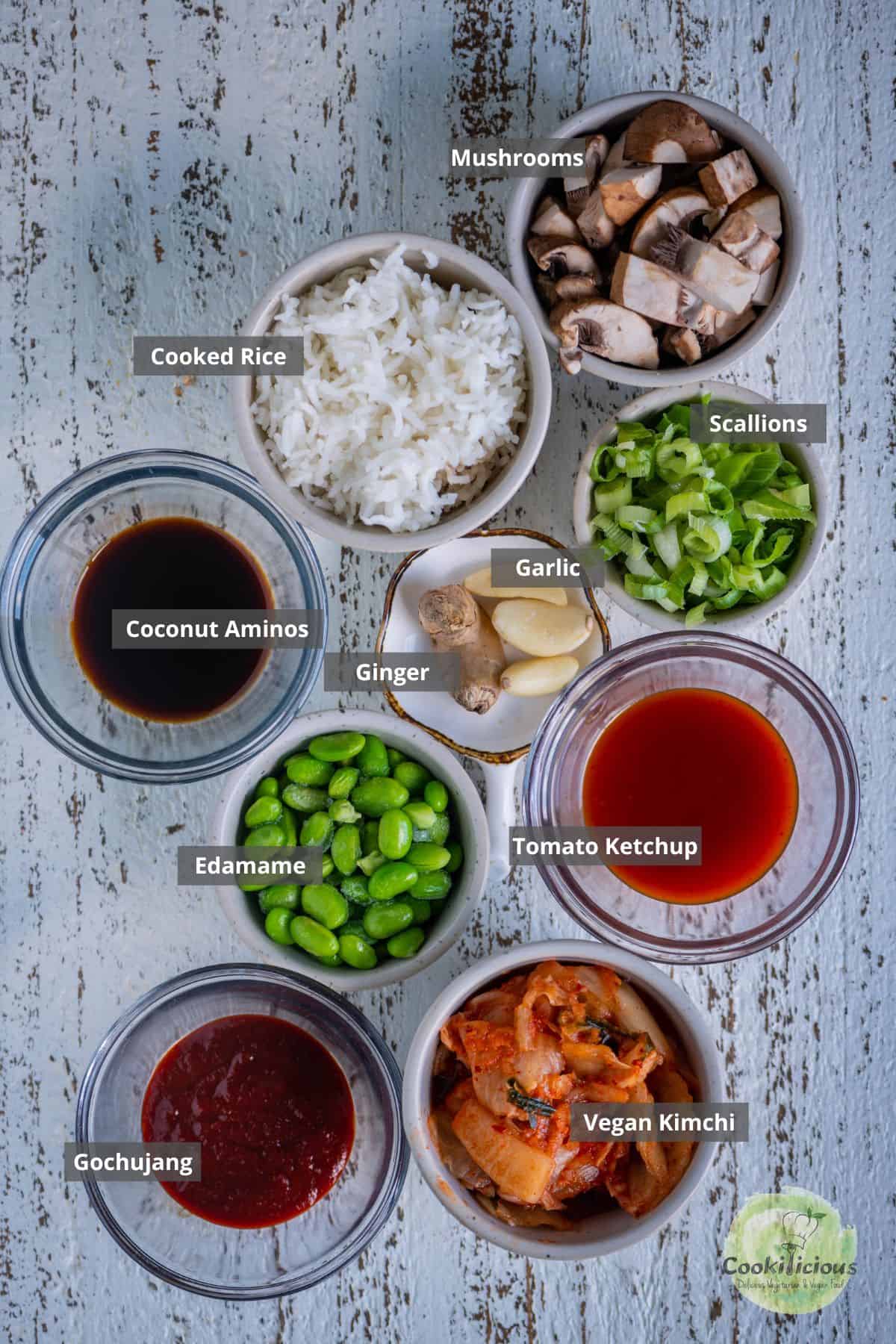
Korean cuisine essentials - Gochujang sauce/paste and vegan Kimchi (mild or spicy). I get them ready from the store. Check the labels to ensure it's vegan. Nasoya (mild) vegan kimchi is the best and that's what I get. You can find both these ingredients in big grocery markets, Asian or Korean grocery stores, and on Amazon.
Additional sauces - Coconut amino sauce is added for that umami flavor and is a popular soy sauce substitute. It's made from fermented coconut palm sap and is soy-free, and gluten-free. It also is lower in sodium than soy sauce, which is why I prefer to use coconut amino sauce instead of soy sauce. You can choose to add either. Now, the traditional Korean stir-fried Bokkeumbap recipes may not call for tomato ketchup, but I like to add some for that extra tang and color. Skip adding it if you don't want to.
Rice - I prefer to use any long-grain rice to make this Korean dish. You can use any cooked leftover rice (cold). Jasmine or any short-grain variety can also be used. If cooking it fresh, cook it well in advance and cool it down.
Veggies - This is where this easy vegan Gochujang Bokkeumbap with Kimchi recipe gets customizable. Add whatever veggies you have at hand. I added frozen shelled edamame for the protein and chopped mushrooms. You can also add enoki mushrooms, broccoli, snap peas, green peas, carrots, and many more veggies of your choice.
Other aromatics - Ginger, garlic, and scallions are essential because they help complete the dish. Other than these ingredients, to keep the flavors authentic, use sesame seed oil or any vegetable oil in this vegan Korean Bokkeumbap recipe. Vegan butter can also be used but olive oil may not do justice to this dish.
I like to use this Wok whenever I make anything Asian! I love it! If you don't have a wok, use a wide skillet.
How To Make It 🔪
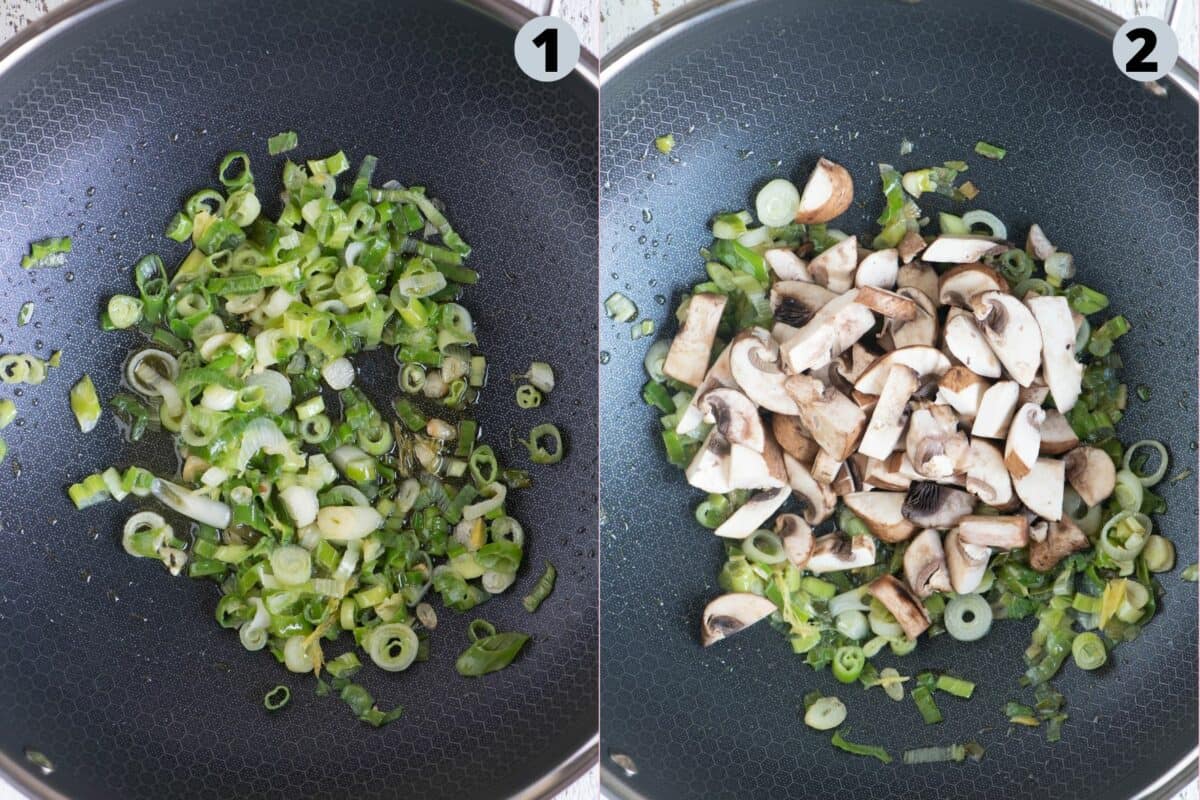
Want to save this recipe?
Before you begin, ensure you have cooked rice that's cooled down, and ready. You can cook it in the Instant Pot or in a Rice Cooker.
- Heat sesame oil in a wok. Fry sliced garlic and crushed ginger along with chopped scallions (reserve some for garnish).
- Add and saute the mushrooms for 2-3 minutes.
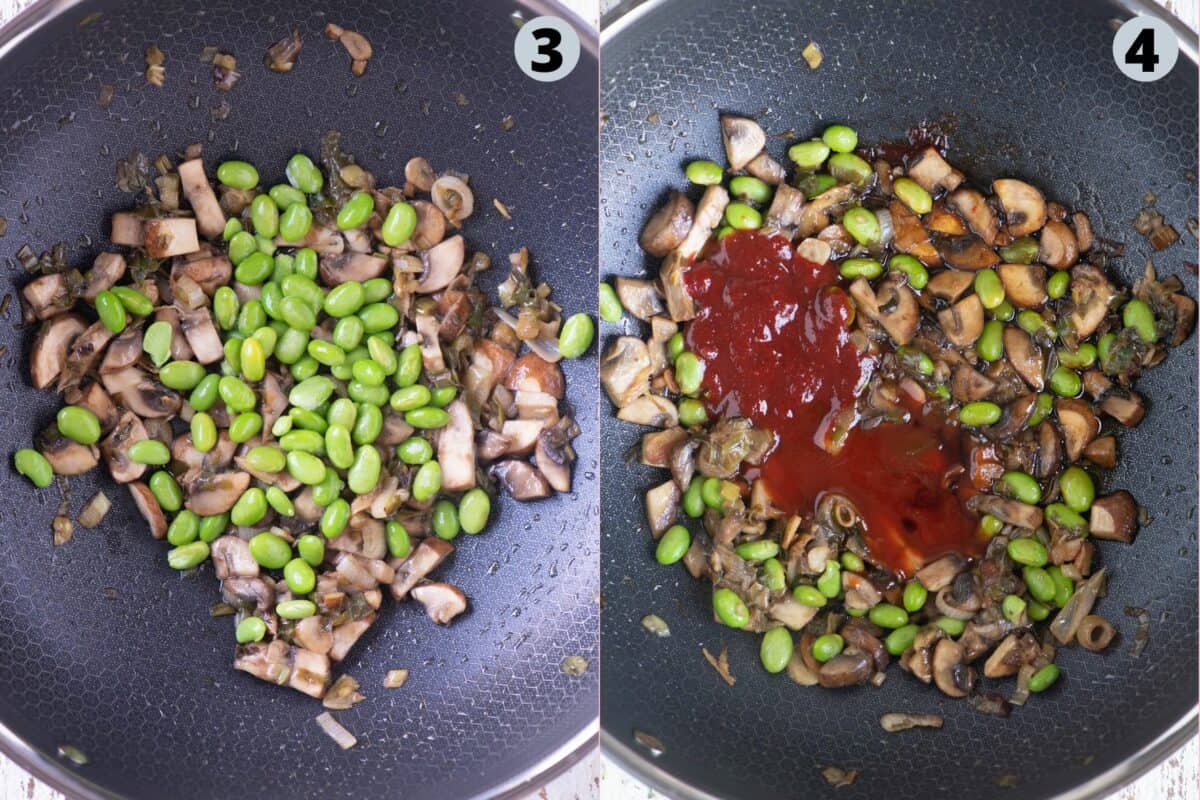
- Now add the edamame. Continue to saute for another minute.
- Then add the sauces like tomato ketchup, gochujang sauce, and coconut amino sauce. Fry for a minute.
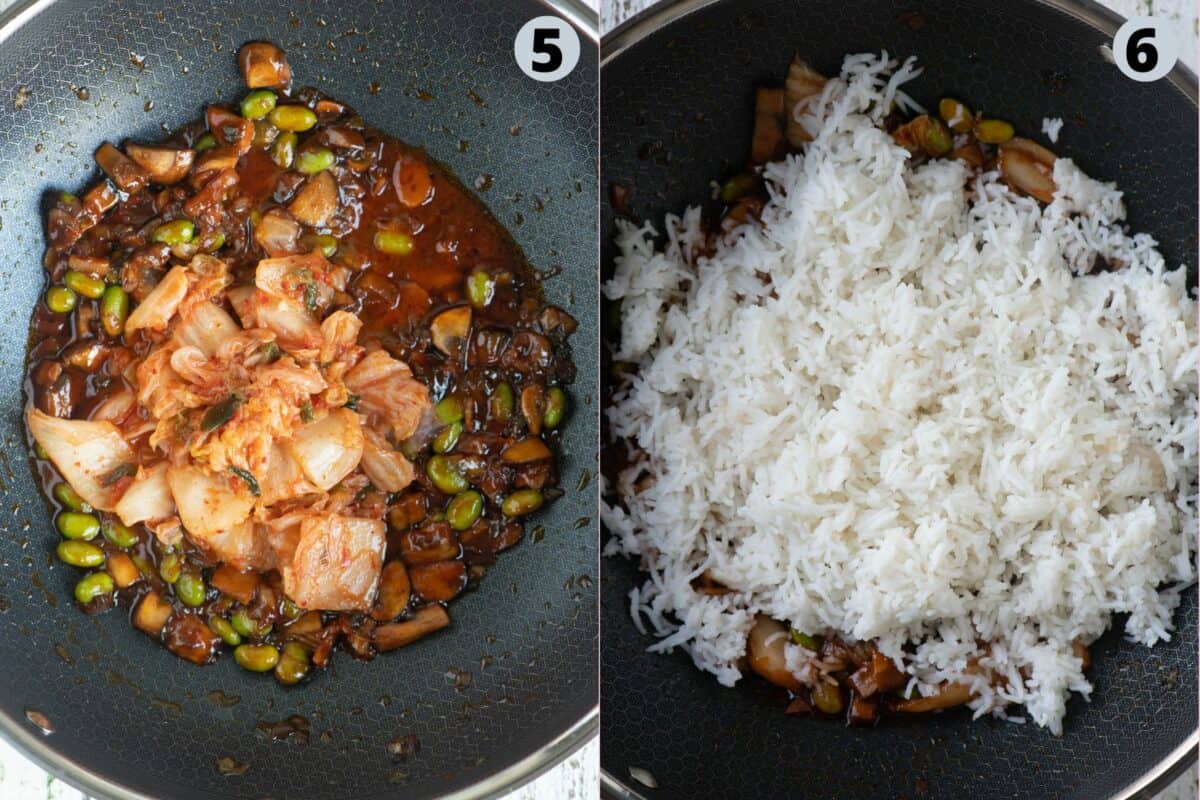
- Now add the vegan Kimchi along with its juice and continue to saute for a minute or till it's slightly caramelized. Sauteeing will also reduce the strong pungent flavor of kimchi. Chef tip - If the Kimchi is too chunky, chop it roughly before adding it to the wok. Don't add too much of the kimchi juice, or else the Kimchi Bokkeumbap will get soggy.
- Add the cooked rice along with salt once the water has reduced. Break up chunks and mix till it's all well combined. Make sure to break up any clumps. However, do not stir continuously as that could break the grains. Garnish with leftover chopped scallions.
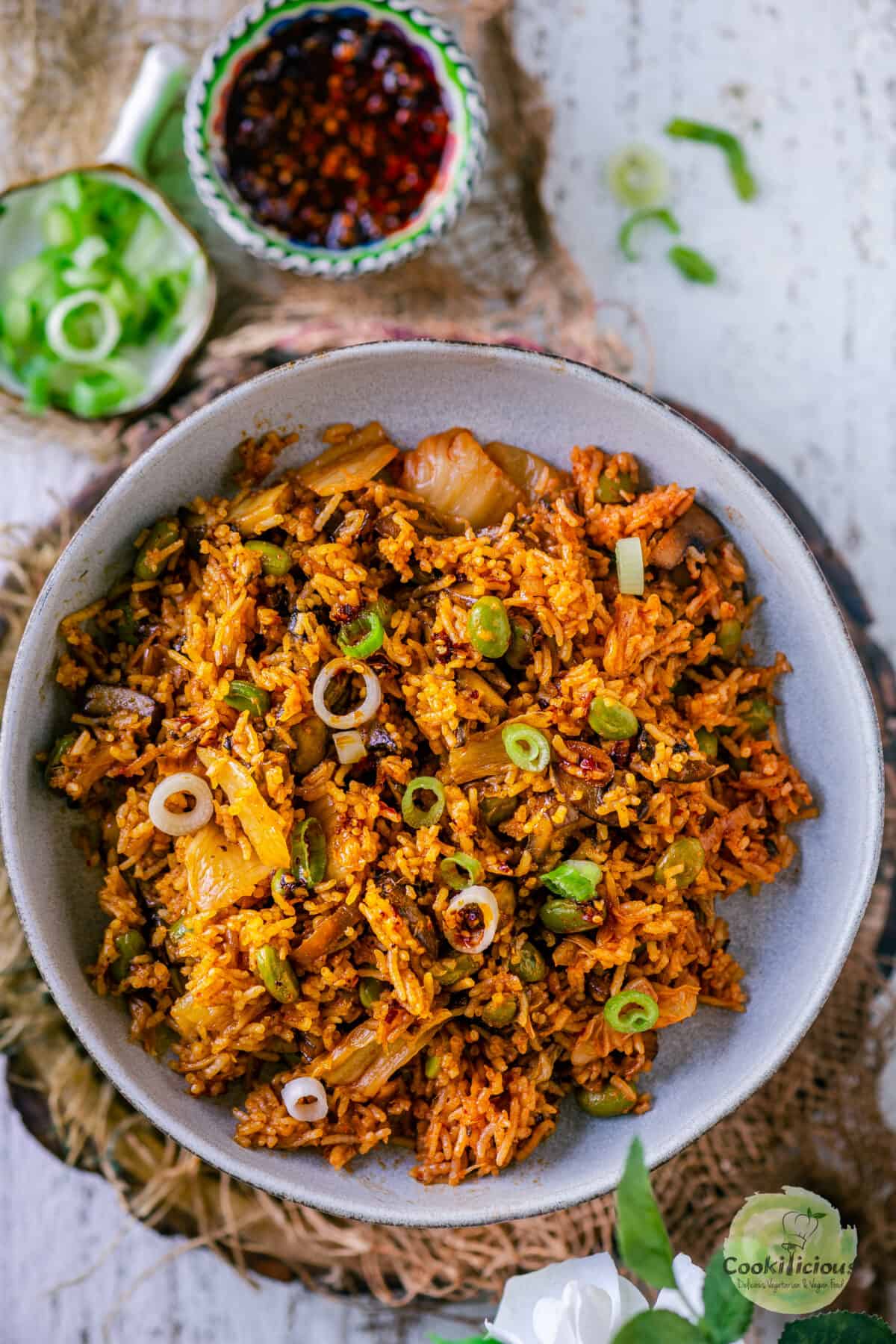
Serving Suggestions 🍽
Serve this vegan/vegetarian Korean Kimchi Gochujang fried rice in individual bowls with chopsticks or spoons on the side. To keep it authentic, serve in Korean Bulgogi Bowls. Drizzle sesame oil on top and serve Korean Bokkeumbap by itself or throw in a side of stir-fried paneer/tofu, mung sprouts salad, sauteed mushrooms, or broccoli. Korean Kimchi Gochujang stir-fried rice bowl is just the dish you want to add to your weeknight rotation since it is so easy and quick to make. It's also a great meal prep recipe. Now you'll never need to order this at the restaurant again once you start making this at home! It's the best, cheapest, healthier, and quickest Korean mid-week meal.
Korean Kimchi Bokkeumbap bowl can be served for breakfast, lunch, dinner, or as a hearty afternoon snack. Serve Kimchi fried rice bowl on weekdays, or towards the end of the week when you are out of fresh produce and don't know what to make! You can also pack it in lunchboxes because it's a satisfying and filling dish. You can also serve it as a side when doing an Asian-themed dinner. BTW, if you love turning leftover rice into something better, then give these recipes a try as well - Broccoli Fried Rice, Fodnicha Bhat, Coconut Rice, Tomato Rice, Mint Pistachio Rice, and Thai Basil Rice.
Priya's Recipe Tips 💭
If you want to make it soy-free, skip the edamame. Coconut amino sauce is already soy-free and is a substitute for soy sauce. If it helps, whisk together the kimchi juice, gochujang sauce/paste, coconut amino sauce, and tomato ketchup in a small bowl beforehand. Then pour it over the rice. To get more kick, add half a teaspoon of gochugaru (Korean chile powder).
If you feel the gochujang paste is very spicy, add just one tablespoon to start with. Doubanjiang is less spicy and probably the best substitute for Gochujang. Sriracha can also be used instead. But remember, sriracha is more spicier than gochujang, so add accordingly. You can make this dish as spicy or as mild as you prefer. Squeeze out the kimchi juice if you don't want your Korean Gochujang Bokkeumbap to be soggy. I added it with the juice though.
FAQs 📖
Use long or medium-grain varieties like Basmati, Jasmine, Haiga, or any short-grain Japanese rice for dishes like these. You can also use leftover cooked rice because the separate grains give the dish the right texture and brown easily. If cooking it fresh, then cook it well in advance and cool it down. Some alternatives to white rice are brown rice, quinoa, couscous, farro, wheat berries, noodles, ramen, or cauliflower rice for a lighter version. You can also use ramen in this recipe to make Kimchi Noodles!
Since this is a no-meat recipe, feel free to add more veggies of your choice. You can add broccoli, enoki mushrooms, snap peas, green peas, bell peppers, eggplants, celery, zucchini, bean sprouts, bok choy, leeks, kale, cauliflower, cucumbers, spinach, finely diced cooked potatoes, and carrots. Fresh or frozen veggies can be added. To add more protein, you can add extra firm tofu, tempeh, soya chunks, or chickpeas. You can also add soaked meatless crumbles to give it a meaty texture.
If you want this Korean Bokkeumbap to have a crust and crispy texture, the most important thing to do is not to constantly stir the rice while frying. Let it sit in the Wok for 1-2 minutes to form a crust at the bottom similar to a Paella. Then stir it up, and then let it sit again for another 1-2 minutes. This way you'll get some crispy bits throughout the finished rice. Another key thing is, be generous with cooking oil. The more the oil, the crispier the rice will be.
To make Korean Bokkeumbap crispy outside and cheesy inside, use a mixture of vegan cheddar and mozzarella! The cheddar adds a nice flavor, and the mozzarella makes this dish super creamy and comforting. In an oven-safe skillet or baking dish, layer cooked Korean Bokkeumbap and vegan cheese alternatively. Top it with a layer of cheese, cover the skillet, and bake at 350 degrees F for 30-40 minutes or till the bottom is crisp and the cheese has melted. A quick fix to this would be to garnish the Korean Bokkeumbap with shredded vegan cheese on top before serving.
Since this is a vegan recipe, we are not using fried eggs as a topping. Some plant-based toppings that go well with this Kimchi Gochujang Bokkeumbap are pickled cucumbers or radishes. You can even top it with some kimchi. The tangy and crunchy textures of the pickled vegetables will lend a refreshing contrast to this Bokkeumbap. To give it that extra kick, I like to drizzle hot chili oil on top before serving. Toasted black or white sesame seeds, scallions, sliced avocado, red pepper flakes, and/or strips of roasted seaweed can also be added as toppings.
You can make this recipe as part of your meal prep. Cook the white rice and store it in the fridge. Then toss in all the ingredients along with rice on a busy weeknight for a quick meal! Store leftover vegetarian/vegan Korean kimchi Bokkeumbap for 4-5 days or in the freezer for up to 2 months. To reheat, transfer to a bowl and microwave, or add to a pan and heat. Sprinkle water to moisten the rice before reheating. Leftover Kimchi can be stored in the fridge for 3-4 months and can be added to stews, pancake batter, soups, or pasta. If the smell, coloring, or texture of the kimchi changes, then discard it. Kimchi should always be stored submerged in the liquid. This prevents the kimchi from spoiling.
More Vegan Fried Rice Recipes
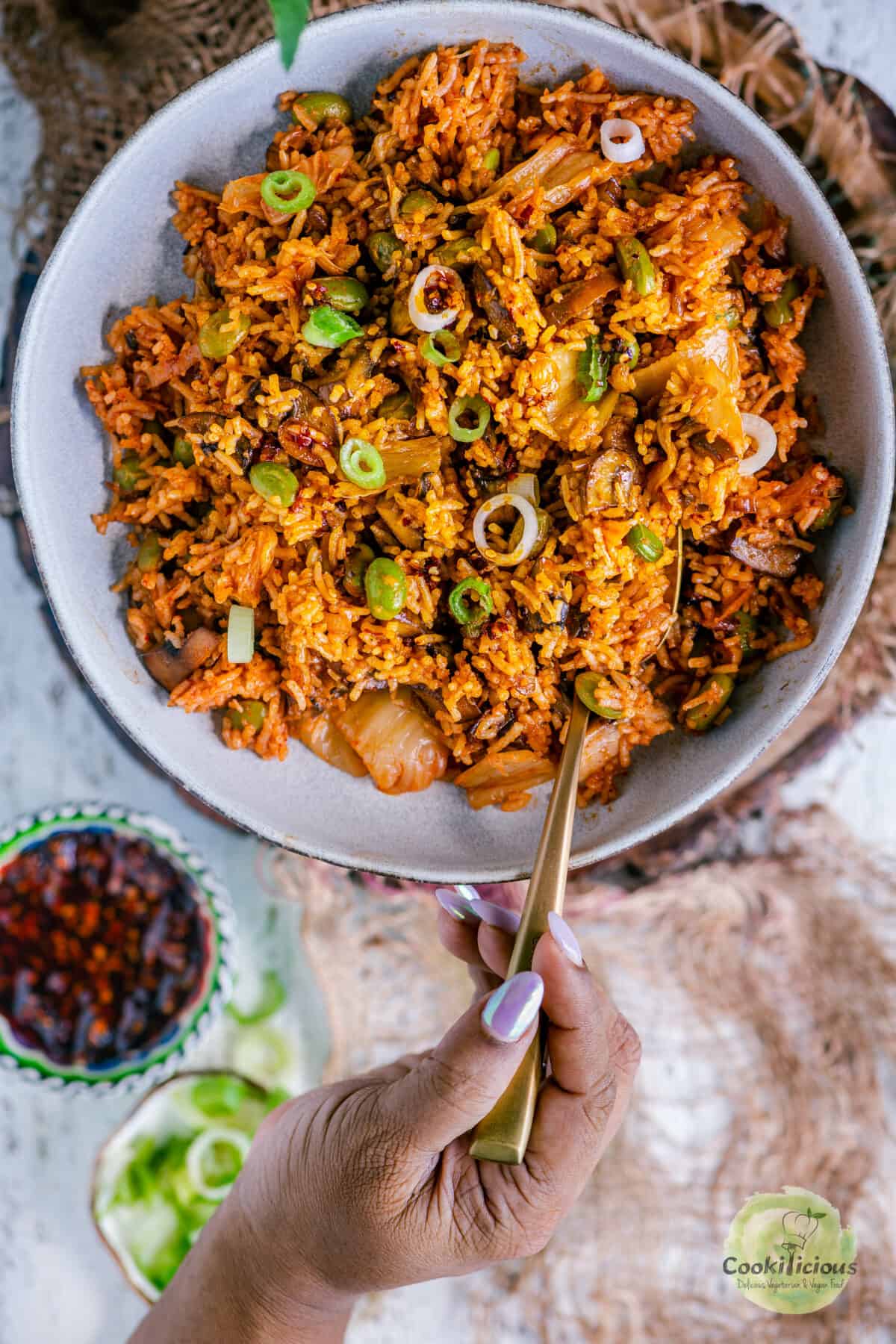
⭐️ Subscribe to the Cookilicious Newsletter and receive new recipes straight to your inbox! You'll receive my FREE Vegan Beginner's guide as a gift. Ready to elevate your cooking game? Purchase my Cookbook - The Essential Vegan Indian Cookbook today!
Recipe 📖
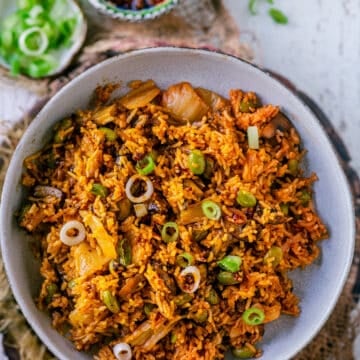
Vegan Korean Gochujang Kimchi Fried Rice
Equipment
Ingredients
- 1 tbsp sesame oil
- 5 cloves sliced garlic
- 1 inch crushed ginger
- 1 cup chopped scallions
- ⅓ cup edamame
- 1 cup chopped mushrooms
- 2 tablespoon tomato ketchup
- 2 tablespoon gochujang
- 1 tablespoon coconut amino sauce or soy sauce
- 1 cup Kimchi
- 2 cups cooked rice
- salt to taste
Instructions
- Before you begin, ensure you have cooked rice that's cooled down, and ready. You can cook it in the Instant Pot or in a Cooker.
- Heat sesame oil in a wok. Fry sliced garlic and crushed ginger along with chopped scallions (reserve some for garnish).
- Add and saute the mushrooms for 2-3 minutes.
- Now add the edamame. Continue to saute for another minute.
- Then add the sauces like tomato ketchup, gochujang sauce, and coconut amino sauce. Fry for a minute.
- Now add the vegan Kimchi along with its juice and continue to saute for a minute or till it's slightly caramelized. Sauteeing will also reduce the strong pungent flavor of kimchi. Chef tip - If the Kimchi is too chunky, chop it roughly before adding it to the wok. Don't add too much of the kimchi juice, or else the Kimchi Bokkeumbap will get soggy.
- Add the cooked rice along with salt once the water has reduced. Break up chunks and mix till it's all well combined. Make sure to break up any clumps. However, do not stir continuously as that could break the grains. Garnish with leftover chopped scallions.

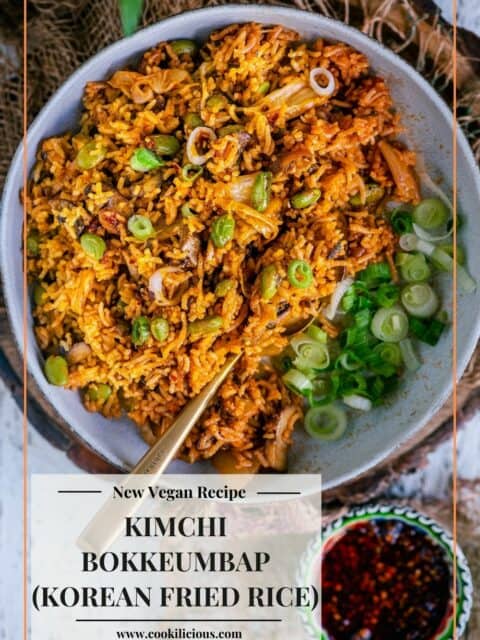
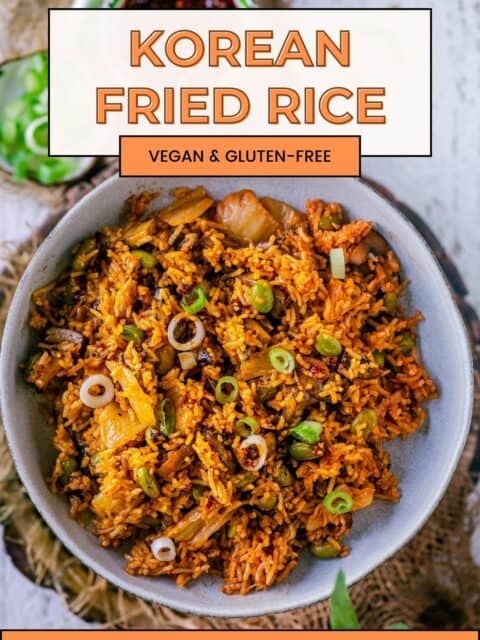

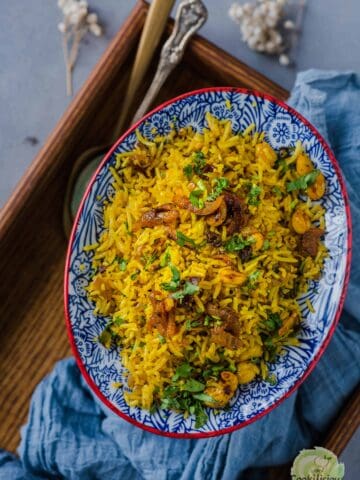

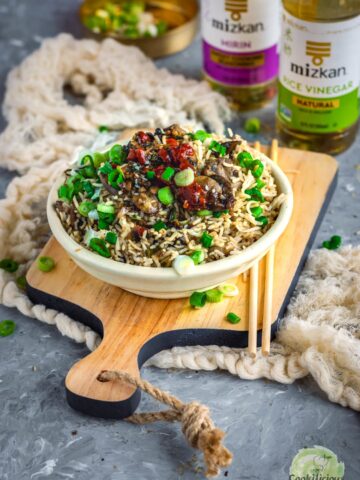
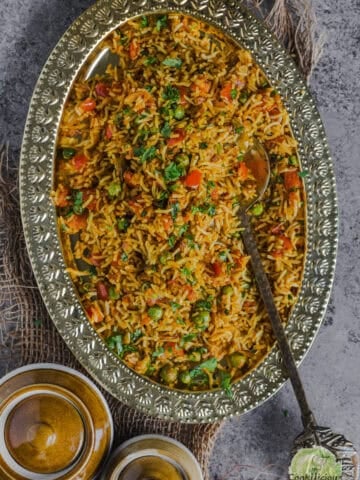
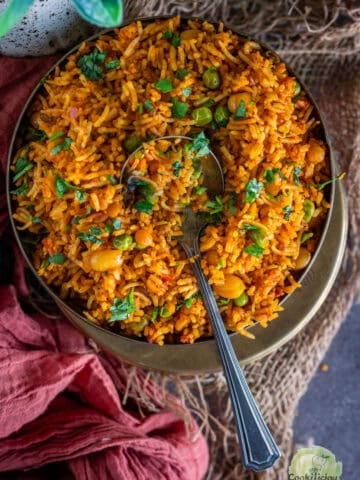

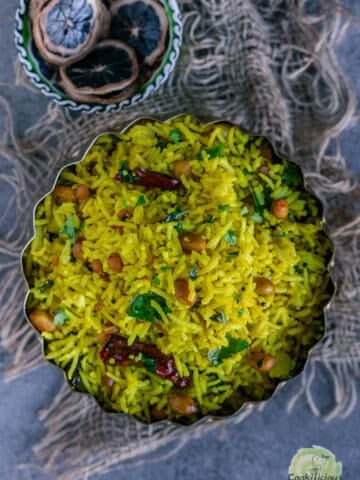

Leave a Reply